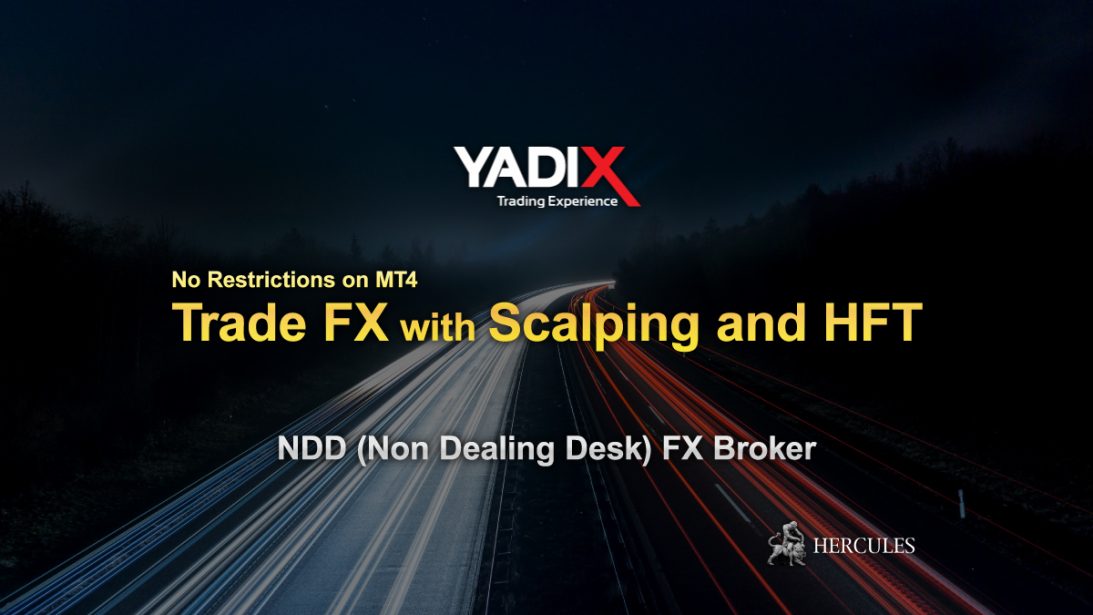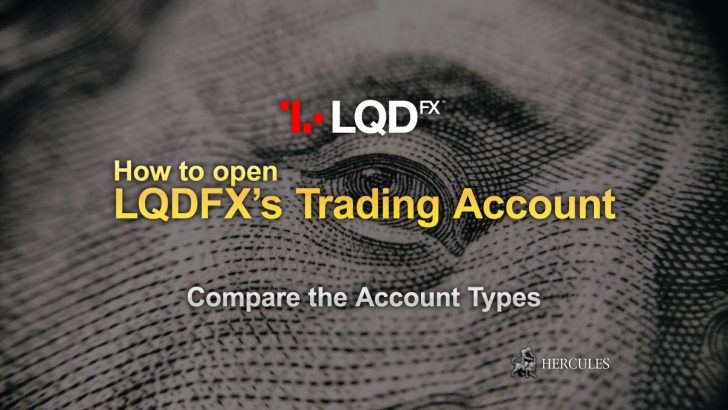Recommended Forex Broker for Scalping and HFT (High Frequency Trading)


Table of Contents
- Perform Scalping, HFT and Arbitrage with no limit
- Learn Technical Analysis for "Scalping" and "HFT"
- What is technical analysis?
- Difference of Technical and Fundamentals analysis?
- What indicators are used in technical analysis?
- Types of trend indicators
- Types of oscillator indicators
- What to be careful with technical analysis?
- There are infinite number of combinations of Technical Indicators
Perform Scalping, HFT and Arbitrage with no limit
Yadix is an online Forex and CFD broker which set no restrictions on trading strategies on its trading platform, MT4.
As Yadix is a NDD (Non Dealing Desk) and STP (Straight Through Processing) broker, there is no conflict of interest between Yadix and its traders.
Thus Yadix supports its traders to succeed while allowing any kinds of trading methods to be performed on its trading platforms.
While Yadix has no restrictions on its trading platforms, the broker also offers low spread from 0.0 pips.
For instance, the average spread of EUR/USD is around 0.1 pips, providing an optimal trading condition for traders who performs Scalping and HFT (High Frequency Trading).
Have you had any troubles with any other brokers due to your trading style, or your profit was cancelled because you were making too much money?
Try Yadix with no trading restrictions, and start trading in your style.
For more information about Yadix’s order execution, visit the page here.
Learn Technical Analysis for “Scalping” and “HFT”
When trading FX, it is not good to trade without grounds because markets continues to rise and fall somehow.
Technical analysis is a method of analyzing past data and predicting future price movements.
You need to study this technical analysis thoroughly in order to make a valid transaction, especially when making trades for short period of time.
Technical analysis is a crucial factor when performing scalping or HFT (High Frequency Trading).
In this article, we will explain the techniques of technical analysis, types of indicators, combination examples, and points to note.
What is technical analysis?
Technical analysis is a method of predicting future price movements by visualizing past price movements as a chart and conducting a psychological analysis of the investment behavior of the people participating in the trade.
The chart shows past movements such as whether the majority of people participating in the trade are buying or selling, or making a profit.
As for the movement of money in the entire market, it can be confirmed that there is a bias in investment such as overbought and oversold, and whether trading is active or not.
The analysis period span of the chart changes depending on the time axis.
The units of the time axis are roughly classified into the following three types.
| Minutes: | 1 minute, 5 minutes, 15 minutes, 30 minutes, 45 minutes |
|---|---|
| Hourly bar: | 1 hour, 4 hours, 12 hours |
| Others: | Daily foot, weekly foot, monthly foot |
Yadix MT4 features all of the above time-frames on the price charts.
The time-frame used depends on the trading style.
The rough correlation between the trading style and the time axis of the chart is as follows.
- Scalping
- The main hourly bars used for entry are 1-minute and 5-minute bars.
- Day trade
- Complete trades on the 15 or 30 minute during the day.
- Swing trade
- Trade using the hour bar of 1 hour or more.
- Long-term holding
- Trade using a weekly or monthly bar to identify a major turning point.
It is common to use the time axis for confirming the large movement of the market and the time axis for the entry timing.
After seeing the movement of the market price on a large time axis, judge the entry timing on a smaller time axis.
Difference of Technical and Fundamentals analysis?
In addition to technical analysis, there are fundamentals analysis methods for analyzing FX market.
Fundamental analysis is an analysis method that predicts future price movements based on the economic conditions of each country.
The economic status of each country is judged by the economic indicators, policy interest rate movements, and economic news that are regularly announced.
On the other hand, technical analysis is a method of analyzing what kind of movements and aims the people actually participating in the foreign exchange market are trading.
Technical analysis tries to derive market movements from the movements of market participants.
Fundamental analysis tries to read the movement of the foreign exchange market from external factors surrounding the foreign exchange market such as economic indicators of the country, so the information to be analyzed is completely different.
Technical analysis and fundamentals analysis are like two wheels predicting price movements in the foreign exchange market, and by incorporating both well, you can raise the price movement forecasting system.
Yadix provides both Fundamental and Technical analysis reports on the website daily for its traders.
What indicators are used in technical analysis?
In technical analysis, what is called an indicator is displayed on the chart for analysis.
Indicators used for technical analysis are classified into two types, trend type and oscillator type.
Charts that show the flow of price movements are called trend charts, and charts that show the movement of money over the entire market are called oscillator charts.
Let’s take a deeper look while illustrating the features of each of the trends and oscillators.
The indicator is used as a judgment material when starting (entry) FX trading and confirming profit or loss.
For example, oscillator-type stochastics are often used for contrarian trading, where a buy order is placed if the currency is oversold and a sell order is placed if the currency is overbought.
From the idea that a flow that largely tilts in one direction will return to the original in a recoil, Stochastic displays it so that you can understand which direction the market price movement is tilting.
Standard indicators can be drawn with chart tools of any Forex company, but advanced indicators are often only supported by some Forex companies.
Whether or not you support the indicator you want to use is also a key point when choosing an FX company.
In case of Yadix MT4, you can utilize all the major and advanced technical indicators for free.
Types of trend indicators
First of all, from the trend indicators, here are the 6 types that are often used.
- Candlestick
- Simple moving average
- Exponential moving average
- Parabolic
- Bollinger band
- Ichimoku Kinko Hyo
1. Candlestick
Candlestick is a trend analysis method that was born in Japan during the Edo period.
If it is a 10-minute bar, the opening price, the high price, the low price, and the closing price are taken out from the price movement during the 10 minutes and expressed by one stick called a candle.
If the closing price is higher than the opening price, it is called the positive line, and if the closing price is higher than the opening price, it is called the hidden line.
Candles are arranged in time series for each time unit, and the next price movement is predicted.
2. Simple moving average
An indicator that charts the average price over the past certain period is called a simple moving average.
Generally, 3 short-term (5 days), medium-term (25 days), and long-term (75 days) are used at the same time.
It is a method of predicting the timing of entry or profit (or stop loss) by observing the movement of the moving average line in the short term that is fast in response to price movements.
The timing at which the short-term moving average moves out of the long-term moving average from the bottom to the top is called the “golden cross”, and the opposite pattern is called the “dead cross”, which are used as the trading timing.
The golden cross is a buy signal and the dead cross is a sell signal.
3. Exponential moving average
The simple moving average is used by adding the price movements for the specified number of days as they are.
On the other hand, the index exponential moving average adopts the result of index calculation in which the current price is emphasized rather than the past price, which is the difference from the simple moving average.
The exponential moving average is characterized by a quicker response to price movements and a signal output at an earlier timing than the simple moving average.
Since the reaction is fast, it is also a big merit that it can move fast, but on the other hand, it is important to note that there is a lot of deception.
4. Parabolic
It is an indicator that uses the turning point (SAR) of the foreign exchange market.
If SAR is set in advance, SAR will appear from the upper side to the lower side of the chart showing the actual price movement.
Then, if the SAR reverses the position above or below the chart, you may want to settle the buy or sell held until then and place the opposite order.
It is an indicator that displays the standard deviation of the price movement and the range of the normal distribution at a certain point of time/time axis and is used for both normal and reverse tension.
5. Ichimoku Kinko Hyo
The Ichimoku Kinko Hyo is a trend indicator that was born in Japan like the candlesticks and uses the candlestick and the five lines to predict price movements.
It is used to know when the buyer and seller are out of balance and the price moves in a certain direction, or when it reaches the target price.
A major feature is that the time axis is important for prediction.
Types of oscillator indicators
Following trend trends, we will introduce 7 types of oscillator indicators.
- MACD
- Stochastic
- Slow Stochastic
- RSI
- DMI
- RCI
- Deviation rate
1. MACD
MACD is an oscillator-based indicator that uses two lines, the MACD calculated using the moving average line and the MACD signal.
If the MACD breaks above the MACD signal, it will be a buy signal and vice versa.
This type is often used with candlestick charts and moving averages.
2. Stochastic
Stochastic is an oscillator-type indicator that expresses how strong or weak the currency is at a certain timing and a certain time axis.
Within the fluctuation range for a certain period, two lines (“%K” and “%D”) are used to identify oversold and overbought, and the sell and buy signals are picked up.
If “%K” surpasses “%D”, it is a buy signal, and in the opposite case, it is a sell signal.
Furthermore, it is possible to improve the accuracy of signals by checking whether these signals occur in the “overbought zone” or “oversold zone”.
Stochastics tend to give more signals in the range than in the trend.
3. Slow Stochastic
Stochastics use% D, but Slow Stochastic use% SlowD (also% SD).
As a result, trading signals are generated less frequently than Stochastics, so they are often used for medium- to long-term trading.
4. RSI
RSI stands for Relative Strength Index, an indicator devised by J.W. Wilder in 1978.
By using the price movements for a certain period of time, you can judge whether they are oversold or overbought.
For example, if there are 4 upsides and 6 downsides within a 10 day period, the RSI value will be 40.
If the RSI is low, it will be oversold, and if it is high, it will be overbought, and it will be used as a basis for buying and selling.
However, be careful when deciding how much the RSI value is oversold or overbought, because there is a big difference depending on the currency and the season.
5. DMI
DMI, like RSI, is the creator of J.W. Wilder and is one of the indicators to judge the strength of the trend.
+DI is a rising power, -DI is a falling power, ADX is a line showing the strength of the trend, and +DI is a buy signal when it surpasses -DI, and the opposite is a sell signal.
6. RCI
RCI is calculated using two rankings over a period of time.
RCI is higher when the price is higher and overbought.
If the price makes a higher high, the indicator’s signal lines also make higher highs. If the price makes lower lows, the indicator’s signal lines also make lower lows.
The highest RCI is 100 and the lowest is -100.
The trading signal is judged by the timing of repulsion above RCI 80 or below -80 and the timing of 0 when RCI breaks up or breaks down.
7. Deviation rate
Deviation rate means the moving average line deviation rate, which is an indicator showing how much the current price deviates from the moving average line.
It is used for contrarian use, taking advantage of the fact that the more it deviates from the moving average line, the more transactions such as profits and loss cuts increase, and the pressure in the opposite direction increases.
What to be careful with technical analysis?
The main risks and points to note in technical analysis are summarized in the following 2 points.
1. Technical analysis could show delayed data
Technical analysis is a method of predicting future movements by analyzing results based on all “past” data.
It is not 100% because it predicts future movements from a statistical point of view.
Often, when you analyze and predict that this trend will continue, it often does not.
There is new information that has not been added to the movement up to that point, and the trend often moves to the next phase.
Be aware that you may be late for trading.
2. Technical analysis could be wrong
It often happens that “selling signals” and “buying signals” appear on the chart, but they are actually not.
Keep in mind that there are many different trading signals for an indicator, but often one signal can be tricky.
There are infinite number of combinations of Technical Indicators
By combining indicators, you can avoid damaging and improve the accuracy of trading signals, and you will be able to efficiently carry out FX trading.
However, displaying too many indicators just because they can be combined increases the risk of confusion and difficulty in analysis.
Examples of simple indicator combinations include trend candlesticks and moving averages, and oscillator MACD/RSI.
Even if you add your favorite indicator to the chart in this state, let’s keep it about one more.
Divergence is one of the cases in which trading signals are judged using a combination of indicators.
If you look at price movements in a trend system and check if the oscillator system is oversold or overbought, the oscillator system oversold indicator may weaken despite the price drop.
This phenomenon is called “divergence” and is famous as one of the reliable trading signals.
There are many more indicators besides the ones introduced in this article, such as trend indicators that display candles on different time axes on one chart, and oscillator CCI indicators that use price movement cycles.
It’s also important to try various indicators and find one that is easy for you to use.











